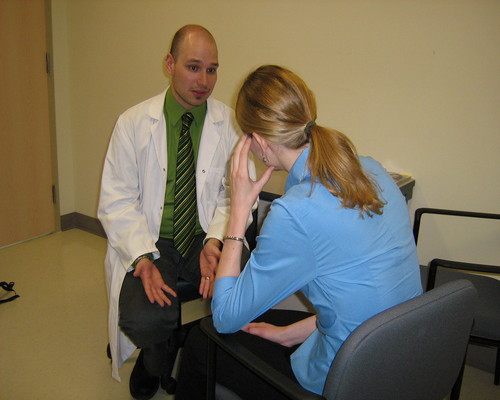



Breaking bad news
Breaking bad news can be a difficult thing to do. Many physicians describe feeling stressed after delivering bad news [1]. Breaking bad news can lead to a very emotional encounter with a patient and their caregivers. Avoiding these interactions until there is "the right time" usually prolongs the stress of this type of encounter. Developing a strategy for breaking bad news will help with one’s confidence in handling these interactions. Toronto oncologist, Dr. Robert Buckman is well known for his work in oncology and has written a book called "Breaking Bad News" [4]. He recommends the S-P-I-K-E-S strategy as a memory aid for breaking bad news. Further discussion of this strategy is available in article form as well. [5]
The Breaking Bad News e-learning module developed by the Queens University Clinical Skills Program [6] is detailed below. The mnemonic SAD NEWS is easy to remember and includes "W" for WAIT which is an important component that gives a patient time to feel and convey emotion. This moment of expressing grief on the presence of a health care provider can be quite supportive and meaningful.

SAD NEWS
S- Set up and Sit down
ensure privacy, introduce self and identify who is in the room, sit down
A- Ask, don’t tell
use open-ended questions to ask what that person knows of the situation
D- Deliver the news
"I’m sorry to tell you..."
"Unfortunately, I have some bad news to tell you..."
N- No fancy lingo
use easily understood language, be direct
E- Expect, permit, respond to Emotion
anticipate and permit a range of emotion including anger, acknowledge the emotion with verbal or nonverbal responses (offer tissue, put hand on shoulder)
W- WAIT
wait for signs that the family member/friend is ready to listen again and move on
S- Support and Summarize
invite questions, relate information with respect and understanding, avoid excessive bluntness, offer presence of nurse, social worker or clergy, offer to be available for questions later
Other approaches to difficult situations and communication strategies can be found in the fast facts of the End-of-Life Physician Education Resource Center.
_________________________________
4. Buckman, R., M.D., Breaking Bad News: A Six-Step Protocol. How to Break Bad News: A guide for Health Care Professionals. John Hopkins, 1992.
5. The Oncologist, Vol. 5, No. 4, 302-311, August 2000
6. Adapted from web-based module developed by Adam Szulewski based on content written by Dr. Linda O'Connor and Dr. Bob McGraw for the Queen's University Clinical Skills Program. meds.queensu.ca/courses/assets/modules/breaking-bad-news/introduction.html
 Previous
Previous